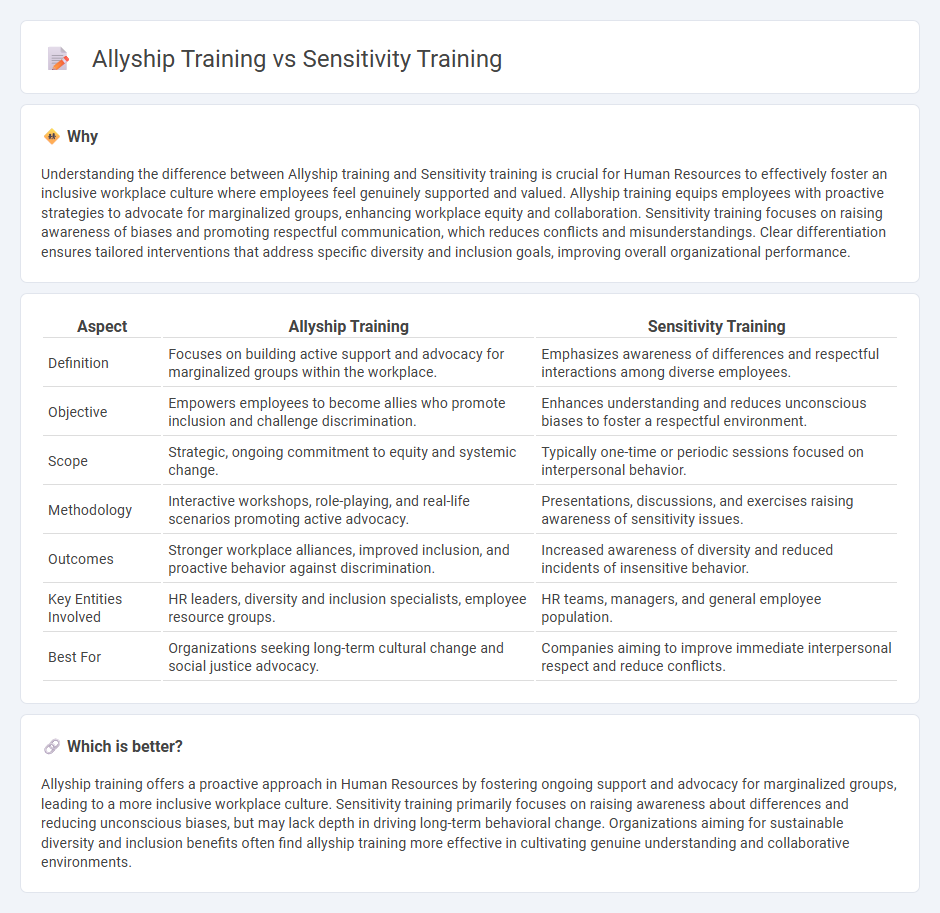
Allyship training focuses on empowering individuals to actively support marginalized groups by promoting inclusivity, understanding systemic inequalities, and fostering a culture of advocacy within the workplace. Sensitivity training emphasizes recognizing and respecting diverse perspectives, reducing unconscious bias, and improving interpersonal communication to create a respectful and harmonious work environment. Discover how integrating both Allyship and Sensitivity training can transform your organization's human resources strategy.
Why it is important
Understanding the difference between Allyship training and Sensitivity training is crucial for Human Resources to effectively foster an inclusive workplace culture where employees feel genuinely supported and valued. Allyship training equips employees with proactive strategies to advocate for marginalized groups, enhancing workplace equity and collaboration. Sensitivity training focuses on raising awareness of biases and promoting respectful communication, which reduces conflicts and misunderstandings. Clear differentiation ensures tailored interventions that address specific diversity and inclusion goals, improving overall organizational performance.
Comparison Table
| Aspect | Allyship Training | Sensitivity Training |
|---|---|---|
| Definition | Focuses on building active support and advocacy for marginalized groups within the workplace. | Emphasizes awareness of differences and respectful interactions among diverse employees. |
| Objective | Empowers employees to become allies who promote inclusion and challenge discrimination. | Enhances understanding and reduces unconscious biases to foster a respectful environment. |
| Scope | Strategic, ongoing commitment to equity and systemic change. | Typically one-time or periodic sessions focused on interpersonal behavior. |
| Methodology | Interactive workshops, role-playing, and real-life scenarios promoting active advocacy. | Presentations, discussions, and exercises raising awareness of sensitivity issues. |
| Outcomes | Stronger workplace alliances, improved inclusion, and proactive behavior against discrimination. | Increased awareness of diversity and reduced incidents of insensitive behavior. |
| Key Entities Involved | HR leaders, diversity and inclusion specialists, employee resource groups. | HR teams, managers, and general employee population. |
| Best For | Organizations seeking long-term cultural change and social justice advocacy. | Companies aiming to improve immediate interpersonal respect and reduce conflicts. |
Which is better?
Allyship training offers a proactive approach in Human Resources by fostering ongoing support and advocacy for marginalized groups, leading to a more inclusive workplace culture. Sensitivity training primarily focuses on raising awareness about differences and reducing unconscious biases, but may lack depth in driving long-term behavioral change. Organizations aiming for sustainable diversity and inclusion benefits often find allyship training more effective in cultivating genuine understanding and collaborative environments.
Connection
Allyship training and sensitivity training both focus on fostering inclusive workplace environments by enhancing employees' understanding of diversity and promoting respectful behaviors. Allyship training emphasizes active support for marginalized groups, while sensitivity training raises awareness of unconscious biases and cultural differences. Together, these programs equip organizations to reduce discrimination and improve collaboration among diverse teams.
Key Terms
Empathy
Sensitivity training emphasizes recognizing and respecting diverse perspectives to foster empathy among participants. Allyship training builds on this by encouraging proactive support and advocacy for marginalized groups, deepening empathetic connections through action. Explore how integrating both approaches can transform workplace inclusivity and human understanding.
Inclusion
Sensitivity training educates individuals on recognizing and respecting differences to reduce offensive behavior, while allyship training emphasizes proactive support and advocacy for marginalized groups to foster genuine inclusion. Both approaches contribute to creating an inclusive workplace, but allyship training drives deeper engagement through active participation and empowerment. Discover more about how these training methods transform organizational culture and promote equity.
Bias
Sensitivity training centers on recognizing and mitigating unconscious biases to foster respectful workplace interactions. Allyship training advances this foundation by equipping individuals with actionable strategies to support marginalized groups and challenge systemic discrimination. Explore more insights on enhancing inclusivity through targeted bias-focused training programs.
Source and External Links
Sensitivity Training to Support Workplace Inclusion - Traliant - Sensitivity training focuses on raising awareness of employees' attitudes and behaviors toward people different in race, color, etc., through clear communication, self-awareness, setting expectations, ongoing education, and creating a supportive environment for inclusion at work.
Sensitivity training - Wikipedia - Sensitivity training is a form of training aimed at increasing awareness of one's own goals and prejudices and becoming more sensitive to others and group dynamics, originating from Kurt Lewin's 1940s workshops and linked to encounter groups for personal growth.
What is Sensitivity Training and How to Implement it in the Workplace - Sensitivity training uses group discussions to boost awareness of human diversity beyond physical differences, encouraging communication, self-reflection, setting clear expectations, and continuous learning for inclusive workplace culture.
 dowidth.com
dowidth.com